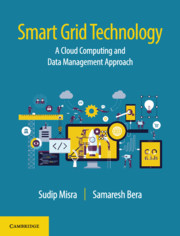Book contents
- Frontmatter
- dedication
- Contents
- Figures
- Tables
- Foreword
- Preface
- Part I Introduction
- 1 Introduction to Smart Grid
- 2 Introduction to Cloud Computing
- 3 Introduction to Big Data Analytics
- 4 Fundamental Mathematical Prerequisites
- Part II Cloud Computing Applications for Smart Grid
- Part III Smart Grid Data Management and Applications
- Part IV Smart Grid Design and Deployment
- Index
3 - Introduction to Big Data Analytics
from Part I - Introduction
Published online by Cambridge University Press: 20 October 2018
- Frontmatter
- dedication
- Contents
- Figures
- Tables
- Foreword
- Preface
- Part I Introduction
- 1 Introduction to Smart Grid
- 2 Introduction to Cloud Computing
- 3 Introduction to Big Data Analytics
- 4 Fundamental Mathematical Prerequisites
- Part II Cloud Computing Applications for Smart Grid
- Part III Smart Grid Data Management and Applications
- Part IV Smart Grid Design and Deployment
- Index
Summary
Big data is conceptualized as a large data set with high complexity that cannot be managed with the traditional data processing schemes in an adequate manner. Big data technology is described as a holistic information management of new types of data alongside traditional data [1]. For example, traditionally, the backbone network carries different homogeneous information generated by end-users. In addition to this, due to the deployment of more number of sensors, actuators, and other different data sources, the network needs to carry heterogeneous information. It is also expected that the same network channel would be used to carry this heterogeneous information. The challenges in big data analytics include analyzing, capturing, processing, searching, storing, and visualizing the large data set. The term ‘big data’ refers to predictive analysis, i.e., predicting the future condition based on the results obtained from processing existing data. Thus, we can predict the system status in advance to take adequate measures to deal with situations in real-time.
According to the existing literature, there is no hard and fast definition of big data. As mentioned earlier, big data is a conceptualized term that is used to represent a large data set, which is complex and heterogeneous in nature. Moreover, it is hard to process such large data set using the traditional applications. Due to the growing need to digitize data, it is required to store and process large amounts of data generated from heterogeneous devices. To get an idea about the amount of data generated over several past years, Figure 3.1 presents certain statistics regarding growth of information storage capacity with digitization of data (adopted from [2]). As can be seen in Figure 3.1, there is a large amount of data being stored in digital storage devices. However, we need efficient processing applications to process such large amount of data before storing it for future use. Different attributes of big data are discussed in the subsequent sections.
Attributes of Big Data
As the name suggests, one of the main attributes of ‘big data’ is volume, i.e., the size of the data. However, it is not only about the volume, but also other factors such as velocity and variety of the data being analyzed. Figure 3.2 presents the attributes diagrammatically. Let us discuss the attributes in detail.
- Type
- Chapter
- Information
- Smart Grid TechnologyA Cloud Computing and Data Management Approach, pp. 38 - 48Publisher: Cambridge University PressPrint publication year: 2018
- 3
- Cited by



